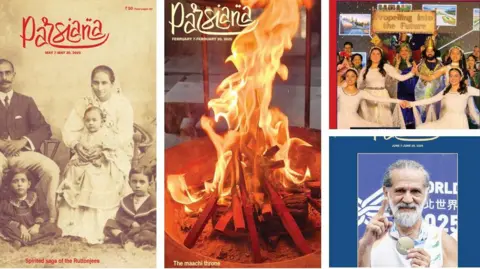In an old, neo-gothic building in Fort, an upmarket area in India's financial capital Mumbai, stands a run-down office that has long produced one of the country’s oldest and most prominent Parsi magazines - Parsiana.
The magazine was started in 1964 by Pestonji Warden, a Parsi doctor who also dabbled in the sandalwood trade, to chronicle the community in the city. Since then, the magazine has grown in subscribers and reach, offering many Parsis a window into the community’s happenings, helping dispersed members feel connected as their numbers dwindle.
However, after 60 years, Parsiana will shut this October, primarily due to dwindling subscribers, financial challenges, and a lack of successors to carry it forward. The announcement has left many subscribers and those familiar with the magazine's legacy deeply saddened.
“It's like the end of an era,” says Sushant Singh, 18, a student. “We used to joke that you weren’t a 'true Parsi' if you didn’t know about Parsiana.”
Since the announcement of its closure, tributes have poured in from readers who reflect on the magazine's unique ability to document an otherwise small community with diligence and passion. A reader noted, “Parsiana has been more than a publication; it has been a companion and bridge connecting Zoroastrians across the world.”
Jehangir Patel, who has led the magazine since buying it for just one rupee in 1973, aimed to create a journalistic endeavor when he took over. Under his leadership, Parsiana transformed from a monthly featuring some essays and writings into a fortnightly publication with reported stories that critically explored sensitive issues within the Parsi community.
Patel recalls breaking new ground by publishing interfaith matrimonial ads in 1987, which sparked significant controversy but also opened discussions within the community. Over the years, the magazine has spotlighted critical issues affecting the Parsis, including their dwindling population and declining religious institutions.
As the publication prepares to close, its 15-member team, mostly in their 60s and 70s who joined under Patel, reflects on a notable career in journalism that is now coming to an end. “We’ve been doing this for a long time,” Patel shares, noting the pressing sense of tiredness mixed with sadness.
The office, with peeling paint and crumbling ceilings, also shows its age, as both the building and the team face their concluding chapters. Though there are no extravagant plans for the last day, upcoming issues will commemorate Parsiana's journey and legacy.
Patel reflects, “It’s a sad occasion. I don't think we’ll feel like celebrating.”






















